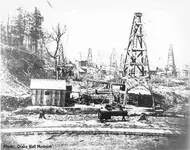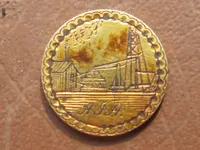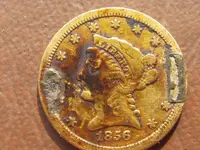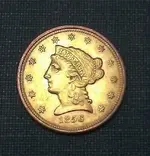You are using an out of date browser. It may not display this or other websites correctly.
You should upgrade or use an alternative browser.
You should upgrade or use an alternative browser.
✅ SOLVED 1856 (First gold, I think...) gold.....what?
- Thread starter Tedyoh
- Start date
kuger
Gold Member
- Joined
- Nov 6, 2007
- Messages
- 9,721
- Reaction score
- 2,798
- Golden Thread
- 0
- Detector(s) used
- ,M.X.T.& Tesoro Tejon
- Primary Interest:
- All Treasure Hunting
Oh,wow!This could be a private mint gold coin,or depending on the size could be a $1, made into a "Love Token",only not for ones "Love".....very exciting and awesome piece!!!It is gold.It appears to have had two pieces soldered to it at one time?
Last edited:
Upvote
0
Tedyoh
Bronze Member
- #3
Thread Owner
Hi Everyone....
Found what I think is a gold necklace pendent or token? Found in north central PA - looks like US Currency but doesn't say "United States Of America" Can someone help me ID this piece?
Thanks in advance!!!
View attachment 847179View attachment 847180
Sorry - Diameter is about 9/16"........thanks.
Upvote
0
Iron Patch
Platinum Member
- Joined
- Sep 28, 2007
- Messages
- 19,257
- Reaction score
- 8,765
- Golden Thread
- 3
- Location
- Dirtyville
- 🥇 Banner finds
- 3
- Detector(s) used
- Deus
- Primary Interest:
- All Treasure Hunting
Oh,wow!This could be a private mint gold coin,or depending on the size could be a $1, made into a "Love Token",only not for ones "Love".....very exciting and awesome piece!!!It is gold.It appears to have had two pieces soldered to it at one time?
yeah made into a brooch or pin. pretty cool.
Upvote
0
Maggie May
Jr. Member
Wow this is great. Could you tell me what kind of gold coin it is? I have never seen one with an oil well on the back, or what appear to be initials . I'm a newbie.
Upvote
0
kuger
Gold Member
- Joined
- Nov 6, 2007
- Messages
- 9,721
- Reaction score
- 2,798
- Golden Thread
- 0
- Detector(s) used
- ,M.X.T.& Tesoro Tejon
- Primary Interest:
- All Treasure Hunting
Maggie,I think it is a $1 gold coin which has been proffesionally engraved with a scene.This was quite commonly done to silver coins,usually with initials.These were called "Love Tokens".They were also sometimes fashioned into cuff links,buttons and like IronPatch pointed out,it looks like this was possibly a BroochWow this is great. Could you tell me what kind of gold coin it is? I have never seen one with an oil well on the back, or what appear to be initials . I'm a newbie.
Upvote
0
Maggie May
Jr. Member
Thank you Kuger. Whom ever it was must have loved the other so much. I mean back in those days $1.00 was worth so much. My Gram had 10 children and my Grandpa made 72 cents in the 1920's a day in the brickyard. In 1856 that had to be a very generous endearment.
Last edited:
Upvote
0
surf
Silver Member
- Joined
- Jan 10, 2013
- Messages
- 2,832
- Reaction score
- 1,458
- Golden Thread
- 0
- Detector(s) used
- seeing eye shovel
- Primary Interest:
- Other
Hello Tedyoh,
Welcome aboard, and thanks for showing us your "love token." It appears to be an Oil well scene to me. Does that make sense in the context it was found?

"A typical 1860's oilfield boiler with mounted engine sits along a siding of the Oil
Creek (Farmer's) Railroad at Tarr Farm, Oil Creek Valley, 1868. The well in the
foreground appears to be a pumper apparently powered by a steam engine in the
engine house. Note cut wood stacked at left and the smoke stack coming out of
the far side of the roof." Steam Engines
Upvote
0
huntsman53
Gold Member
- Joined
- Jun 11, 2013
- Messages
- 6,955
- Reaction score
- 6,772
- Golden Thread
- 0
- Location
- East Tennessee
- Primary Interest:
- Other
The measurement of the coin must be off or the coin was roll squeezed to a specific size. The reason I say this, is because the 1856 $1 Gold Coin which was 13mm (just slightly larger than a half inch) had either a Type I "Small" Indian Princess Head or Type II Large Indian Princess Head on the Obverse and there were no Private Mint coins that would match either. Therefore, it must have been made from an 1856 $2.50 Gold Liberty Head Coin which was 18mm (slightly larger than 11/16th's of an inch) or it is a fake!
Frank
Frank
Last edited:
Upvote
0
HutSiteDigger
Silver Member
- Joined
- Nov 26, 2012
- Messages
- 2,849
- Reaction score
- 1,283
- Golden Thread
- 0
- Location
- Stafford,Virginia
- Detector(s) used
- Fisher 1266x and a shovel
- Primary Interest:
- All Treasure Hunting
Thats something you don't find everyday!!!
Upvote
0
CRUSADER
Emerald Member
Maggie,I think it is a $1 gold coin which has been proffesionally engraved with a scene.This was quite commonly done to silver coins,usually with initials.These were called "Love Tokens".They were also sometimes fashioned into cuff links,buttons and like IronPatch pointed out,it looks like this was possibly a Brooch
No question about it once being a brooch, I've seen that solder mark configuration many times.
Upvote
0
atprolen
Full Member
- Joined
- Jul 25, 2013
- Messages
- 141
- Reaction score
- 69
- Golden Thread
- 0
- Location
- Northern michigan
- Detector(s) used
- Ace350. At pro
- Primary Interest:
- All Treasure Hunting
No matter what it is its a great find. Congrats
Sent from my iPad using TreasureNet
Sent from my iPad using TreasureNet
Upvote
0
AU Seeker
Bronze Member
- Joined
- Oct 14, 2007
- Messages
- 1,574
- Reaction score
- 1,535
- Golden Thread
- 0
- Location
- South Carolina
- Detector(s) used
- E-Track, MXT, CZ6A
- Primary Interest:
- All Treasure Hunting
Very nice find, and I agree that it's sure looks to be gold, have it tested to be sure, but I'm sure you will find that it's gold.
I'm rather sure that it's a downsized reproduction of a 1856 $2.5 1/4 Eagle made as a piece of jewelry and very well done, I say this because of the size, it couldn't be a real 1/4 Eagle at 18mm and sized down, if you compare your find to a real 1856 1/4 Eagle you will see that the flat edge is wider before the dentials starts on the face of the coin than that of a real 1/4 Eagle, so there is no way it could of been sized down and have a wider flat edge.
1856 $2.5 MS Collector Coins | Liberty Head $2.50 Coin Details | NGC Coin Explorer

It is close to the right size to be a 1856 gold $1, but it isn't the correct engraving to be one and the date would be on the reverse not the obverse.
Gold dollar - Wikipedia, the free encyclopedia

The measurement of the coin must be off or the coin was roll squeezed to a specific size. The reason I say this, is because the 1856 $1 Gold Coin which was 13mm (just slightly larger than a half inch) had either a Type I "Small" Indian Princess Head or Type II Large Indian Princess Head on the Obverse and there were no Private Mint coins that would match either. Therefore, it must have been made from an 1856 $2.50 Gold Liberty Head Coin which was 18mm (slightly larger than 11/16th's of an inch) or it is a fake!
Frank
I'm rather sure that it's a downsized reproduction of a 1856 $2.5 1/4 Eagle made as a piece of jewelry and very well done, I say this because of the size, it couldn't be a real 1/4 Eagle at 18mm and sized down, if you compare your find to a real 1856 1/4 Eagle you will see that the flat edge is wider before the dentials starts on the face of the coin than that of a real 1/4 Eagle, so there is no way it could of been sized down and have a wider flat edge.
1856 $2.5 MS Collector Coins | Liberty Head $2.50 Coin Details | NGC Coin Explorer

It is close to the right size to be a 1856 gold $1, but it isn't the correct engraving to be one and the date would be on the reverse not the obverse.
Gold dollar - Wikipedia, the free encyclopedia

Last edited:
Upvote
0
CC Hunter
Hero Member
A very interesting and unique find!!! 
Gold coins are rarely seen that have been smoothed on one side, and jeweler engraved. The practice of jeweler engraving, was indeed quite popular on silver coinage during the later half of the 19th Century. Gold coins however, being of considerable more value, were rarely relegated for these mementos. The remaining solder marks on the one side of this item above, surely attest to being originally affixed to a display piece of jewelry.
The details on the 1856 dated side of this piece, featuring a head with LIBERTY on the band, match with great precision to the Coronet Type gold coins minted in the United States from 1840-1907. Comparing the details on the head side of the engraved piece above, with the details on the standard mint issue 1856 $2.50 gold coin in the photo provided below here, we see a match with all design features and positioning. The smallest of the Coronet Type gold coins, the $2.50 denomination, had an original weight and diameter of 4.18 grams and 18 mm respectively. With a description of about 9/16" diameter in the beginning post (translating to about 14.2 mm), we would however not have a match to a $2.50 Coronet Type gold coin. The diameter as described at 9/16" would indeed be closer to a $1.00 gold coin of 15 mm, yet we may note as well (as has been pointed out in a previous post), that the design on a standard U.S. mint issue $1.00 gold coin of 1856, is entirely different. The standard U.S. mint issue gold coins of 1854-1889, all feature an Indian Head Type design, as well as having other details such as United States of America on the obverse (face side), and no date (the date is on the reverse or back side). At this point, I suspect that original measurement as described of "about 9/16", was not precise, and we may in fact be dealing with a true $2.50 gold coin that more closely matches the measurement of near 11/16" diameter.
The possibility of a Private Mint gold coin can surely be ruled out, as there is only the isolated examples of a $2.50 gold coin featuring a Coronet Type head, along with LIBERTY on the band, with that being the Clark, Gruber & Co. coins of Denver Colorado dated 1860. The small denomination California fractional gold pieces, of $0.25, $0.50, and $1.00, produced at first privately to supplement commerce demand for small currency, and primarily later as tourist and novelty pieces, are known in some examples to feature a Liberty Head design, yet the die work and detail in these pieces is not even close in quality to what we see in regular issue coinage.
The observation by Surf, that the engraved detail on this piece, appears to depict an Oil Well scene is a valid point that I certainly concur with. The fact that Pennsylvania was host to our first great Oil Boom, coincides as well with general location and time frame of this unique gold piece.
Pennsylvania oil rush - Wikipedia, the free encyclopedia
CC Hunter

Gold coins are rarely seen that have been smoothed on one side, and jeweler engraved. The practice of jeweler engraving, was indeed quite popular on silver coinage during the later half of the 19th Century. Gold coins however, being of considerable more value, were rarely relegated for these mementos. The remaining solder marks on the one side of this item above, surely attest to being originally affixed to a display piece of jewelry.
The details on the 1856 dated side of this piece, featuring a head with LIBERTY on the band, match with great precision to the Coronet Type gold coins minted in the United States from 1840-1907. Comparing the details on the head side of the engraved piece above, with the details on the standard mint issue 1856 $2.50 gold coin in the photo provided below here, we see a match with all design features and positioning. The smallest of the Coronet Type gold coins, the $2.50 denomination, had an original weight and diameter of 4.18 grams and 18 mm respectively. With a description of about 9/16" diameter in the beginning post (translating to about 14.2 mm), we would however not have a match to a $2.50 Coronet Type gold coin. The diameter as described at 9/16" would indeed be closer to a $1.00 gold coin of 15 mm, yet we may note as well (as has been pointed out in a previous post), that the design on a standard U.S. mint issue $1.00 gold coin of 1856, is entirely different. The standard U.S. mint issue gold coins of 1854-1889, all feature an Indian Head Type design, as well as having other details such as United States of America on the obverse (face side), and no date (the date is on the reverse or back side). At this point, I suspect that original measurement as described of "about 9/16", was not precise, and we may in fact be dealing with a true $2.50 gold coin that more closely matches the measurement of near 11/16" diameter.
The possibility of a Private Mint gold coin can surely be ruled out, as there is only the isolated examples of a $2.50 gold coin featuring a Coronet Type head, along with LIBERTY on the band, with that being the Clark, Gruber & Co. coins of Denver Colorado dated 1860. The small denomination California fractional gold pieces, of $0.25, $0.50, and $1.00, produced at first privately to supplement commerce demand for small currency, and primarily later as tourist and novelty pieces, are known in some examples to feature a Liberty Head design, yet the die work and detail in these pieces is not even close in quality to what we see in regular issue coinage.
The observation by Surf, that the engraved detail on this piece, appears to depict an Oil Well scene is a valid point that I certainly concur with. The fact that Pennsylvania was host to our first great Oil Boom, coincides as well with general location and time frame of this unique gold piece.
Pennsylvania oil rush - Wikipedia, the free encyclopedia
CC Hunter
Attachments
Upvote
0
Tedyoh
Bronze Member
- #18
Thread Owner
Thanks to Everyone for your research and comments.....I just got home from PA so I pulled out the calipers and scale ( only had a tape measure in PA).......the dia. is 19.9 mm on average and the weight is 3.56 grams.......I guess, since the weight is slightly off, it would then make sense that it was a 2.50 gold piece, reverse ground flat then engraved by a jeweler as CC Hunter mentions? Also, does anyone see any problems with a little more cleaning than just rinsing off in the creek when I found it? I would assume not since it's no longer US currency. The more I look at it, the more I like it, and I'm more and more certain I will keep it - but I do wonder if there is any substantial collector value to these Love Tokens? Thanks again to Everyone.....
Upvote
0
Bramblefind
Silver Member
I buy and sell coin love tokens sometimes and there is definitely value in this one over the gold melt.  It's beautiful and an awesome find!
It's beautiful and an awesome find!
Here is some info on them-
Pictorial | Love Token Society
A landscape like yours would certainly be a sought after piece for a collector.
As CC Hunter said above - the silver coins are far more common but the gold ones do show up. If you search on ebay / google for gold coin love token you will find others.
If it were mine I would clean it
Here is some info on them-
Pictorial | Love Token Society
A landscape like yours would certainly be a sought after piece for a collector.
As CC Hunter said above - the silver coins are far more common but the gold ones do show up. If you search on ebay / google for gold coin love token you will find others.
If it were mine I would clean it

Last edited:
Upvote
0
AU Seeker
Bronze Member
- Joined
- Oct 14, 2007
- Messages
- 1,574
- Reaction score
- 1,535
- Golden Thread
- 0
- Location
- South Carolina
- Detector(s) used
- E-Track, MXT, CZ6A
- Primary Interest:
- All Treasure Hunting
Check online and or with this site for collectors of Love Tokens
Love Token Society
From the same site, some other gold coins made into Love Tokens
Reported Gold Love Tokens | Love Token Society
Love Token Society
From the same site, some other gold coins made into Love Tokens
Reported Gold Love Tokens | Love Token Society
Upvote
0
Similar threads
- Question
- Replies
- 26
- Views
- 2K
- Replies
- 10
- Views
- 856
- Question
- Replies
- 2
- Views
- 517
Users who are viewing this thread
Total: 1 (members: 0, guests: 1)






